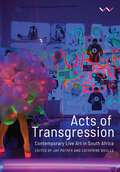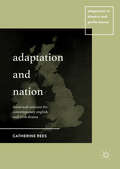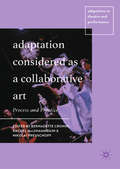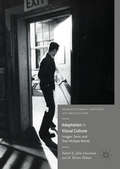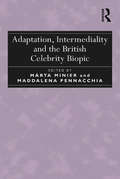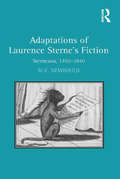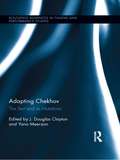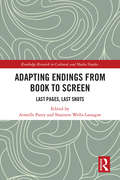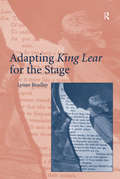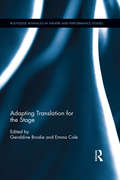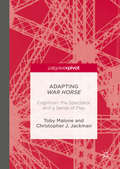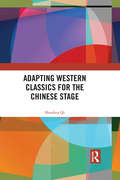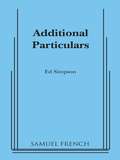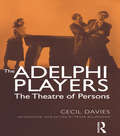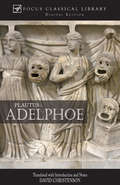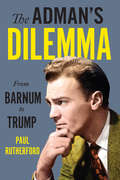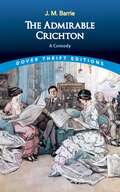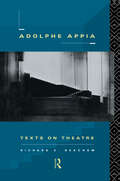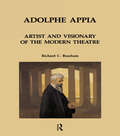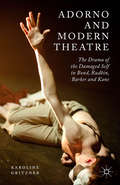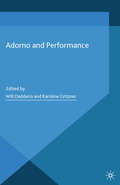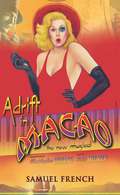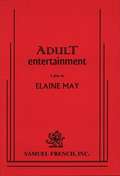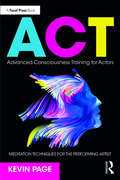- Table View
- List View
Acts of Transgression: Contemporary Live Art in South Africa
by Catherine BoulleFifteen writers explore the experimental, interdisciplinary and radically transgressive field of contemporary live art in South Africa, focusing on a wide range of perspectives, personalities and theoretical concerns Contemporary South African society is chronologically ‘post’ apartheid, but it continues to grapple with material redress, land redistribution and systemic racism. Acts of Transgression represents the complexity of this moment in the rich potential of a performative art form that transcends disciplinary boundaries and aesthetic conventions. The contributors, who are all significantly involved in the discipline of performance art, probe its intersection with crisis and socio-political turbulence, shifting notions of identity and belonging, embodied trauma and loss. Narratives of the past and visions for the future are interrogated through memory and the archive, thus destabilising entrenched colonial systems.Collectively analysing the work of more than 25 contemporary South African artists, including Athi-Patra Ruga, Mohau Modisakeng, Steven Cohen, Dean Hutton, Mikhael Subotzsky, Tracey Rose and Donna Kukama, among others, the analysis is accompanied by a visual record of more than 50 photographs. For those working in the fields of theatre, performance studies and art, this is a must-have collection of critical essays on a burgeoning and exciting field of contemporary South African research.
Adaptation and Nation: Theatrical Contexts for Contemporary English and Irish Drama (Adaptation in Theatre and Performance)
by Catherine ReesThis book takes a novel approach to theatrical adaptation, focusing not primarily on filmic adaptations but instead on modern drama based on older, classic playtexts. The specific focus of the book is the exploration of the new national setting given to the reworked version. In exploring the way in which contemporary dramatists in England and Ireland represent a different national setting for their reworked adaptation, we can examine the specific social and political context for the new play, unearthing the cultural conditions at the time of the new setting. In examining only plays that consciously relocate the national setting for their new work, we can also explore resonances between the two different national contexts, analysing cultural and political echoes as well as shifts both geographical and temporal.
Adaptation Considered as a Collaborative Art: Process and Practice (Adaptation in Theatre and Performance)
by Bernadette Cronin Rachel MagShamhráin Nikolai PreuschoffThis book examines the processes of adaptation across a number of intriguing case studies and media. Turning its attention from the 'what' to the 'how' of adaptation, it serves to re-situate the discourse of adaptation studies, moving away from the hypotheses that used to haunt it, such as fidelity, to questions of how texts, authors and other creative practitioners (always understood as a plurality) engage in dialogue with one another across cultures, media, languages, genders and time itself. With fifteen chapters across fields including fine art and theory, drama and theatre, and television, this interdisciplinary volume considers adaptation across the creative and performance arts, with a single focus on the collaborative.
Adaptation in Visual Culture: Images, Texts, and Their Multiple Worlds (Palgrave Studies in Adaptation and Visual Culture)
by R. Barton Palmer Julie GrossmanThis book offers the first comprehensive discussion of the relationship between Modern Irish Literature and the Irish cinema, with twelve chapters written by experts in the field that deal with principal films, authors, and directors. This survey outlines the influence of screen adaptation of important texts from the national literature on the construction of an Irish cinema, many of whose films because of cultural constraints were produced and exhibited outside the country until very recently. Authors discussed include George Bernard Shaw, Oscar Wilde, Liam O'Flaherty, Christy Brown, Edna O'Brien, James Joyce, and Brian Friel. The films analysed in this volume include THE QUIET MAN, THE INFORMER, MAJOR BARBARA, THE GIRL WITH GREEN EYES, MY LEFT FOOT, THE PICTURE OF DORIAN GRAY, THE SNAPPER, and DANCING AT LUGHNASA. The introduction features a detailed discussion of the cultural and political questions raised by the promotion of forms of national identity by Ireland's literary and cinematic establishments.
Adaptation, Intermediality and the British Celebrity Biopic
by Márta Minier Maddalena PennacchiaBeginning with the premise that the biopic is a form of adaptation and an example of intermediality, this collection examines the multiplicity of 'source texts' and the convergence of different media in this genre, alongside the concurrent issues of fidelity and authenticity that accompany this form. The contributors focus on big and small screen biopics of British celebrities from the late twentieth and twenty-first centuries, attending to their myth-making and myth-breaking potential. Related topics are the contemporary British biopic's participation in the production and consumption of celebrated lives, and the biopic's generic fluidity and hybridity as evidenced in its relationship to such forms as the bio-docudrama. Offering case studies of film biographies of literary and cultural icons, including Elizabeth I, Elizabeth II, Diana Princess of Wales, John Lennon, Shakespeare, Jane Austen, Beau Brummel, Carrington and Beatrix Potter, the essays address how British identity and heritage are interrogated in the (re)telling and showing of these lives, and how the reimagining of famous lives for the screen is influenced by recent processes of manufacturing celebrity.
Adaptations of Laurence Sterne's Fiction: Sterneana, 1760–1840
by Mary-Celine NewbouldExploring how readers received and responded to literary works in the long eighteenth century, M-C. Newbould focuses on the role played by Laurence Sterne’s fiction and its adaptations. Literary adaptation flourished throughout the eighteenth century, encouraging an interactive relationship between writers, readers, and artists when well-known works were transformed into new forms across a variety of media. Laurence Sterne offers a particularly dynamic subject: the immense interest provoked by The Life and Opinions of Tristram Shandy, Gentleman and A Sentimental Journey through France and Italy inspired an unrivalled number and range of adaptations from their initial publication onwards. In placing her examination of Sterneana within the context of its production, Newbould demonstrates how literary adaptation operates across generic and formal boundaries. She breaks new ground by bringing together several potentially disparate aspects of Sterneana belonging to areas of literary studies that include drama, music, travel writing, sentimental fiction and the visual. Her study is a vital resource for Sterne scholars and for readers generally interested in cultural productivity in this period.
Adapting Chekhov: The Text and its Mutations (Routledge Advances in Theatre & Performance Studies #23)
by J. Douglas Clayton Yana MeerzonThis book considers the hundred years of re-writes of Anton Chekhov’s work, presenting a wide geographical landscape of Chekhovian influences in drama. The volume examines the elusive quality of Chekhov’s dramatic universe as an intricate mechanism, an engine in which his enigmatic characters exist as the dramatic and psychological ciphers we have been de-coding for a century, and continue to do so. Examining the practice and the theory of dramatic adaptation both as intermedial transformation (from page to stage) and as intramedial mutation, from page to page, the book presents adaptation as the emerging genre of drama, theatre, and film. This trend marks the performative and social practices of the new millennium, highlighting our epoch’s need to engage with the history of dramatic forms and their evolution. The collection demonstrates that adaptation as the practice of transformation and as a re-thinking of habitual dramatic norms and genre definitions leads to the rejuvenation of existing dramatic and performative standards, pioneering the creation of new traditions and expectations. As the major mode of the storytelling imagination, adaptation can build upon and drive the audience’s horizons of expectations in theatre aesthetics. Hence, this volume investigates the original and transformative knowledge that the story of Chekhov’s drama in mutations offers to scholars of drama and performance, to students of modern literatures and cultures, and to theatre practitioners worldwide.
Adapting Endings from Book to Screen: Last Pages, Last Shots (Routledge Research in Cultural and Media Studies)
by Armelle Parey Shannon Wells-LassagneThis book offers a new perspective on adaptation of books to the screen; by focusing on endings, new light is shed on this key facet of film and television studies. The authors look at a broad range of case studies from different genres, eras, countries and formats to analyse literary and cinematic traditions, technical considerations and ideological issues involved in film and television adaptions. The investigation covers both the ideological implications of changes made in adapting the final pages to the screen, as well as the aesthetic stance taken in modifying (or on the contrary, maintaining) the ending of the source text. By including writings on both film and television adaptations, this book examines the array of possibilities for the closure of an adapted narrative, focusing both on the specificities of film and different television forms (miniseries and ongoing television narratives) and at the same time suggesting the commonalities of these audiovisual forms in their closing moments. Adapting Endings from Book to Screen will be of interest to all scholars working in media studies, film and television studies, and adaptation studies.
Adapting King Lear for the Stage
by Lynne BradleyQuestioning whether the impulse to adapt Shakespeare has changed over time, Lynne Bradley argues for restoring a sense of historicity to the study of adaptation. Bradley compares Nahum Tate's History of King Lear (1681), adaptations by David Garrick in the mid-eighteenth century, and nineteenth-century Shakespeare burlesques to twentieth-century theatrical rewritings of King Lear, and suggests latter-day adaptations should be viewed as a unique genre that allows playwrights to express modern subject positions with regard to their literary heritage while also participating in broader debates about art and society. In identifying and relocating different adaptive gestures within this historical framework, Bradley explores the link between the critical and the creative in the history of Shakespearean adaptation. Focusing on works such as Gordon Bottomley's King Lear's Wife (1913), Edward Bond's Lear (1971), Howard Barker's Seven Lears (1989), and the Women's Theatre Group's Lear's Daughters (1987), Bradley theorizes that modern rewritings of Shakespeare constitute a new type of textual interaction based on a simultaneous double-gesture of collaboration and rejection. She suggests that this new interaction provides constituent groups, such as the feminist collective who wrote Lear's Daughters, a strategy to acknowledge their debt to Shakespeare while writing against the traditional and negative representations of femininity they see reflected in his plays.
Adapting Translation for the Stage (Routledge Advances in Theatre & Performance Studies)
by Geraldine Brodie Emma ColeTranslating for performance is a difficult – and hotly contested – activity. Adapting Translation for the Stage presents a sustained dialogue between scholars, actors, directors, writers, and those working across these boundaries, exploring common themes and issues encountered when writing, staging, and researching translated works. It is organised into four parts, each reflecting on a theatrical genre where translation is regularly practised: The Role of Translation in Rewriting Naturalist Theatre Adapting Classical Drama at the Turn of the Twenty-First Century Translocating Political Activism in Contemporary Theatre Modernist Narratives of Translation in Performance A range of case studies from the National Theatre’s Medea to The Gate Theatre’s Dances of Death and Emily Mann’s The House of Bernarda Alba shed new light on the creative processes inherent in translating for the theatre, destabilising the literal/performable binary to suggest that adaptation and translation can – and do – coexist on stage. Chronicling the many possible intersections between translation theory and practice, Adapting Translation for the Stage offers a unique exploration of the processes of translating, adapting, and relocating work for the theatre.
Adapting War Horse: Cognition, the Spectator, and a Sense of Play
by Toby Malone Chris JackmanThis book analyses the success and adaptation of Michael Morpurgo's novel War Horse to stage, radio, live events, and feature film, in different cultures, on tours, and in translation. In under a decade, War Horse has gone from obscure children's novel to arguably one of the world's most recognisable theatrical brands, thanks to innovative puppet designs from South Africa's Handspring Puppet Company in an acclaimed stage production from the National Theatre of Great Britain. With emphasis on embodied spectatorship, collaborative meaning-making, and imaginative 'play,' this book generates fresh insights into the enduring popularity of the franchise's eponymous protagonist, Joey, offering the most in-depth study of War Horse to date.
Adapting Western Classics for the Chinese Stage
by Shouhua QiAdapting Western Classics for the Chinese Stage presents a comprehensive study of transnational, transcultural, and translingual adaptations of Western classics from the turn of the twentieth century to present-day China in the age of globalization. Supported by a wide range of in-depth research, this book Examines the complex dynamics between texts, both dramatic and socio-historical; contexts, both domestic and international; and intertexts, Western classics and their Chinese reinterpretations in huaju and/or traditional Chinese xiqu; Contemplates Chinese adaptations of a range of Western dramatic works, including Greek, English, Russian, and French; Presents case studies of key Chinese adaptation endeavors, including the 1907 adaptation of Uncle Tom’s Cabin by the Spring Willow Society and the 1990 adaptation of Hamlet by Lin Zhaohua; Lays out a history of uneasy convergence of East and West, complicated by tensions between divergent sociopolitical forces and cultural proclivities. Drawing on disciplines and critical perspectives, including theatre and adaptation studies, comparative literature, translation studies, reception theory, post-colonialism, and intertextuality, this book is key reading for students and researchers in any of these fields.
Additional Particulars
by Ed Simpson3m, 1f / Comedy / Interiors The intersecting lives of four "Save-a-Bundle Discount Mart" employees are explored in Additional Particulars. In the first act, Glenda Balitski, an optimistic but lonely young woman who works in housewares, has recently moved into her tidy apartment after the death of her invalid mother. Assistant Manager Warren Grippo, a generous but awkward man of unflagging good manners, has unexpectedly dropped by Glenda's apartment after work. After the lonely couple discovers a shared enthusiasm for the corporate ideals of "Save-a-Bundle," Warren reveals that Glenda has been chosen "Employee of the Month..." and confesses his desire to discuss with her some "additional particulars" of a more personal nature. Meanwhile, Raymond Fetterman, a maintenance man and himself a former "Employee of the Month" is having lunch with his young friend and co-worker, Kenny Hinkle. It is the eve of Raymond's 47th birthday, he's trapped in a job he hates, and Raymond has come to the painful realization that time is quickly running out on his chances of "having a life." As Raymond desperately yearns to escape the monotony of his life, the good-natured Kenny sympathetically listens...and harbors a heartbreaking secret of his own. This play was awarded the LA Drama Critics Circle Award, Backstage West's Garland Award, and was a Critic's Choice in the LA Times. "Human comedy par excellence, as if Chekhov were reincarnated in America's Wal-Mart culture...Simpson's sympathy and affection for (his character's) weaknesses are signs of that rare combination of humanist with a genuine sense of humor." - Los Angeles Times "...Witty and insightful...not just a very funny show, but an unexpectedly poignant and decidedly human as well...Simpson writes with an unusual degree of humanity..." - Variety "...E
The Adelphi Players: The Theatre of Persons
by Dr Cecil DaviesCecil Davies' The Adelphi Players: The Theatre of Persons represents a uniquely interesting contribution to our understanding of touring British theatre in the mid-twentieth-century, post-war period. This book will interest everyone - whether student, academic or general reader - who wants to know more about issues concerning the recent history of British theatre. In their values and aims, the Adelphi Players pre-empted many of the post-war developments that we associate with the non-commercial, fringe and community theatre movement. In Richard Heron Ward founder of the Adelphi-Players, we encounter a dramatist, novelist, essayist and poet who has been unusually neglected in terms of our appreciation of the English literature of the broad left in the 1930s, `40s and `50s. The Adelphi Players has been edited by Peter Billingham, who has also provided an introduction placing Ward and the Adelphi players in the wider social, cultural and ideological context.
Adelphoe: The Brothers
by Terence David ChristensonThe play Adelphoe provides an introduction to the world of Roman comedy from one of its best practitioners, Terence. As with all Focus translations, the emphasis is on an inexpensive, readable edition that is close to the original, with an extensive introduction, notes and appendices.
The Adman’s Dilemma: From Barnum to Trump
by Paul RutherfordThe Adman’s Dilemma is a cultural biography that explores the rise and fall of the advertising man as a figure who became effectively a licensed deceiver in the process of governing the lives of American consumers. Apparently this personage was caught up in a contradiction, both compelled to deceive yet supposed to tell the truth. It was this moral condition and its consequences that made the adman so interesting to critics, novelists, and eventually filmmakers. The biography tracks his saga from its origins in the exaggerated doings of P.T. Barnum, the emergence of a new profession in the 1920s, the heyday of the adman’s influence during the post-WW2 era, the later rebranding of the adman as artist, until the apparent demise of the figure, symbolized by the triumph of that consummate huckster, Donald Trump. In The Adman’s Dilemma, author Paul Rutherford explores how people inside and outside the advertising industry have understood the conflict between artifice and authenticity. The book employs a range of fictional and nonfictional sources, including memoirs, novels, movies, TV shows, websites, and museum exhibits to suggest how the adman embodied some of the strange realities of modernity.
The Admirable Crichton: A Comedy (Dover Thrift Editions)
by J. M. BarrieOnce a month, Lord Loam encourages his servants to enter the drawing room for tea. This ritual defiance of tradition disturbs Crichton, the butler, who regards the class system as "the natural outcome of a civilized society." When the entire household is shipwrecked and stranded on a desert island, a new social order emerges - with comic results for master and servant. This classic English comedy, written by the author of Peter Pan, combines light entertainment with serious undertones concerning the class structure of British society during the early twentieth century. First produced in 1902, the play was adapted for radio and television and has been frequently revived on the stage.
Adolphe Appia: Texts on Theatre (Contemporary Theatre Studies #Vol. 6)
by Richard C. BeachamAdolphe Appia swept away the foundations of traditional theatre and set the agenda for the development of theatrical practice this century. In Adolphe Appia: Texts on Theatre, Richard Beacham brings together for the first time selections from all his major writings. The publication of these essays, many of which have long been unavailable in English, represents a significant addition to our understanding of the development of theatrical art. It will be an invaluable sourcebook for theatre students and welcomed as an important contribution to the literature of the modern stage.
Adolphe Appia: Texts On Theatre (Contemporary Theatre Studies #Vol. 6)
by Richard C. BeachamFirst Published in 1994. Routledge is an imprint of Taylor & Francis, an informa company.
Adorno and Modern Theatre: The Drama of the Damaged Self in Bond, Rudkin, Barker and Kane
by K. GritznerAdorno and Modern Theatre explores the drama of Edward Bond, David Rudkin, Howard Barker and Sarah Kane in the context of the work of leading philosopher Theodor W. Adorno (1903-1969). The book engages with key principles of Adorno's aesthetic theory and cultural critique and examines their influence on a generation of seminal post-war dramatists.
Adorno and Performance (Performance Philosophy)
by Will Daddario Karoline GritznerAdorno and Performance offers the first comprehensive examination of the vital role of performance within the philosophy of Theodor W. Adorno. Capacious in its ramifications for contemporary life, the term 'performance' here unlocks Adorno's dialectical thought process, which aimed at overcoming the stultifying uniformity of instrumental reason.
Adrift in Macao
by Christopher DurangFull Length, Musical / 4m, 3f /Unit Sets Nominated for a Drama Desk Award for Best Music Set in 1952 in Macao, China, ADRIFT IN MACAO is a loving parody of film noir movies. Everyone that comes to Macao is waiting for something, and though none of them know exactly what that is, they hang around to find out. The characters include your film noir standards, like Laureena, the curvacious blonde, who luckily bumps into Rick Shaw, the cynical surf and turf casino owner her first night in town. She ends up getting a job singing in his night club - perhaps for no reason other than the fact that she looks great in a slinky dress. And don't forget about Mitch, the American who has just been framed for murder by the mysterious villain McGuffin. With songs and quips, puns and farcical shenanigans, this musical parody is bound to please audiences of all ages. "And there are of course those songs... Melnick demonstrates an affinity for melody and old-fashioned showmanship that link him to his grandfather, Richard Rodgers..."- Matthew Murray, Talkin' Broadway.com "... with a drop-dead funny book and shamefully silly lyrics by Christopher Durang and lethally catchy music by Peter Melnick. A Drift In Macao lovingly parodies the Hollywood film noir classics of the 1940's and 50's..." - Michael Dale, Broadwayworld.com
Adult Entertainment
by Elaine MayComedy / 3m, 3f / Unit Set There is a cloud over porn queen Heidi the 'Ho's usually cheery cable TV show. Her guests are wearing armbands to mourn the passing of their employer and mentor, a legendary porn filmmaker. Tired of working for others, this motley group of adult video veterans decides to write and shoot their own extravaganza, an "art" film. The script doesn't live up to their expectations so they bring in a new writer, one who insists they read the classics to prepare for their roles. Unexpected ideas develop as the hilarity escalates bringing the play to a raucous and riotous conclusion.
Advanced Consciousness Training for Actors: Meditation Techniques for the Performing Artist
by Kevin PageAdvanced Consciousness Training for Actors: Meditation Techniques for the Performing Artist explores theories and techniques for deepening the individual actor’s capacity to concentrate and focus attention. Going well beyond the common exercises found in actor training programs, these practices utilize consciousness expanding "technologies" derived from both Eastern and Western traditions of meditation and mindfulness training as well as more recent discoveries from the fields of psychology and neuroscience. This book reviews the scientific literature of consciousness studies and mindfulness research to discover techniques for focusing attention, expanding self-awareness, and increasing levels of mental concentration; all foundational skills of the performing artist in any medium.
